Wax Begonia: Flower, Leaves – Plant Care Guide (Pictures)
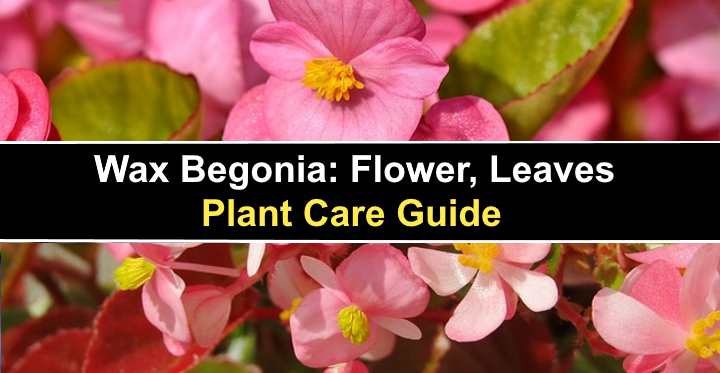
Wax begonia (Begonia Semperflorens-Cultorum) is a group of beautiful begonia plants with green, bronze, or reddish-brown waxy leaves that grow in compact, bushy mounds. Wax leaf begonias are popular bedding plants that grow as annuals or warm-weather perennials. Growing in dappled sunlight, the spreading, low-growing bedding begonias produce clusters of white, pink, or red flowers that bloom from summer until fall.
Wax Begonia (Begonia Semperflorens-Cultorum) in the Annual Garden
Wax begonia (also known as bedding begonia) is one of the most popular annuals for growing in flower beds, borders, containers, hanging flower baskets, window boxes, and houseplants. Wax begonias are easy to grow and maintain, and have tremendous ornamental value for your garden landscape or home interior.
Wax begonias are the most widely planted bedding flowers due to their long blooming time and dense, mounding growth. The botanical name semperflorens means “everblooming.” The begonia’s common name—wax begonia—refers to the waxy gloss of the rounded or ovate leaves.
There are over 1,500 different begonia species and hundreds of hybrids.
This article is a complete guide to growing wax begonias outdoors and indoors. You will also find out about this attractive annual bedding plant’s leaves and flowers so you can maximize its visual effect.
Wax Begonia Plant (Begonia semperflorens-cultorum)
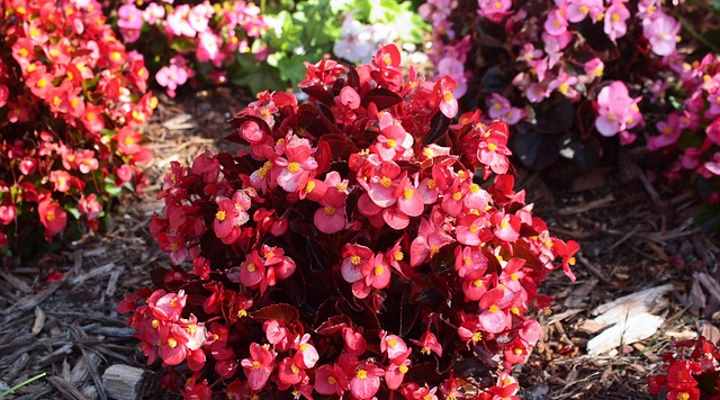
Wax begonia (Begonias Semperflorens Cultorum)
Wax begonias belong to the hybrid group of begonias Semperflorens Cultorum in the family Begoniaceae. Begonia semperflorens have fibrous roots, fleshy stems, and shiny, waxy leaves in various shades of green and brown.
Wax begonias grow between 6” and 12” (15 – 30 cm) tall and spread up to 12” (30 cm).
Wax begonias grow best in full sun to partial shade. The green-leafed begonia semperflorens varieties grow best in dappled sunlight or partial shade. The bronze-leafed and dark-leafed begonias perform better in full sun.
Wax begonia (begonia semperflorens) plants are herbaceous perennials in USDA zones 10 and 11. In colder climates, begonias are annual bedding plants as they don’t tolerate frost. You can plant begonias as annuals every spring or overwinter them indoors in containers during winter.
The clumping habit of wax begonias and low spread make them ideal for ground cover, hanging baskets, along walkways, planting in containers, or flowering border plants.
Wax begonias have a fast growth rate once they grow into seedlings. After transferring the seedlings to your garden in spring, the bedding begonias will grow quickly and fill spaces in your garden beds and borders. Planting wax begonias in mass allows you to cover bare ground and add colorful foliage and flowers to your garden landscape.
Wax Begonia Flower
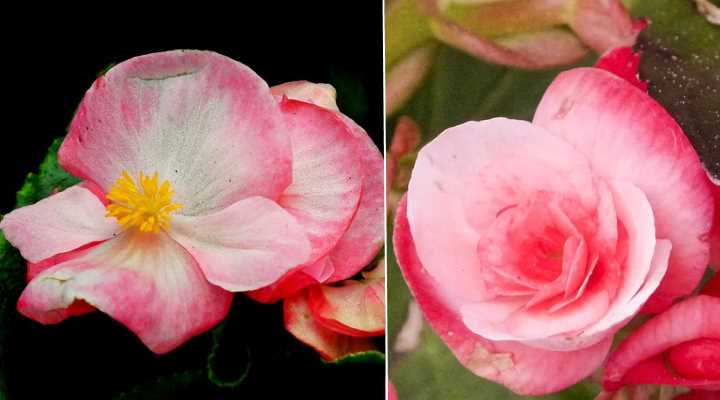
Wax begonia can have single or double flowers
Wax begonia flowers are typically pink, white, red, or a combination of those colors. Individual begonia flowers have four or five petals, and they grow in loose clusters of single or double flowers. Wax begonia flowers bloom from May until October, creating a lush mat of color.
Wax Begonia Leaves
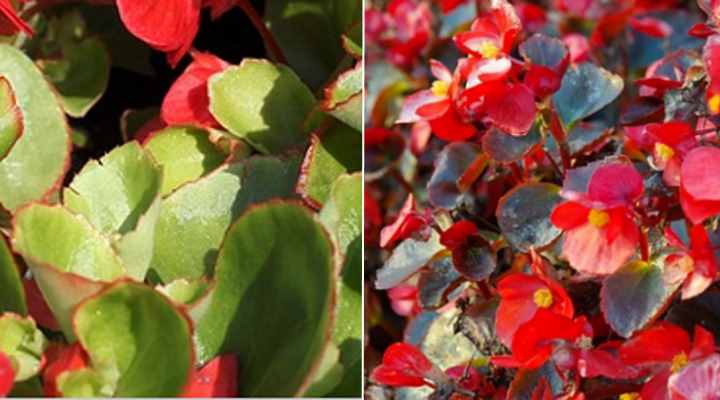
Wax begonia leaves can be green or shades of bronze
Wax begonia has a waxy round or ovate-shaped leaves that have a glossy sheen that creates an eye-catching carpet of showy foliage. Wax begonia leaves are green or various shades of brown, bronze, or copper. The alluring shiny leaves can be light green to dark bronze.
Wax Begonia Plant Care
Wax begonias grow best in full sun or partial shade in moist, well-drained, rich fertile soil. It’s a good idea to put a layer of mulch to retain moisture during hot summers. Once established, no pruning is needed to encourage bushy growth and prolific flowering.
When growing potted wax begonias, water the soil enough to keep it moist, without becoming soggy. The time to water begonias in containers is when the top layer of soil is dry. Pour water evenly around the pot until it drains from the drainage holes.
Wax begonias are also drought-tolerant plants if the weather is not too hot and sunny.
How to Plant Annual Wax Begonia in the Garden
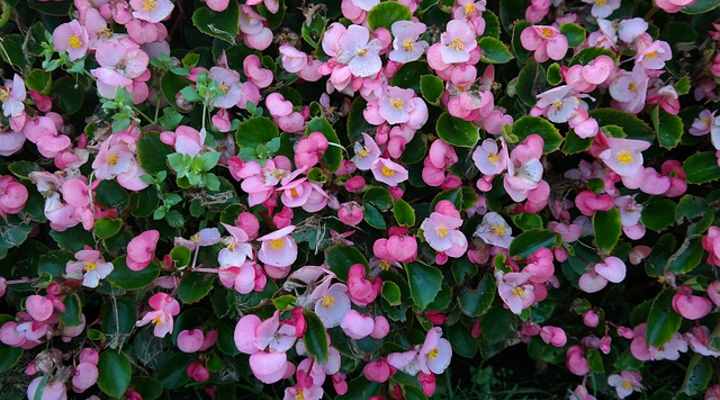
Plant wax begonia in partial shade or dappled sunlight
Annual wax begonias are one of the easiest plants to grow in gardens. The wax begonia seeds are tiny and need to be started indoors. Once the seeds germinate and seedlings appear, you can plant wax begonias in the ground when the temperature is constantly above 50°F (10°C).
Start growing begonia seeds indoors in January or 12 weeks before the last expected frost date. Sow the powder-like seeds in a sterile potting mix and don’t cover them with soil—they need light to germinate. Cover with clear plastic to increase humidity and allow enough light through. Keep indoor temperatures between 70°F and 75°F (21°C – 24°C). The seeds should germinate in around 20 days.
When to plant wax begonia: Plant wax begonias in the ground when the threat of frost has passed. Temperatures below 50°F (10°C) will kill the tender annuals.
Where to plant wax begonia: The best place to plant wax begonias is in partial shade or dappled sunlight. Bronze-leafed wax begonias withstand full sun better than the green-leafed varieties. Begonias grow best in slightly acidic soil, so it’s a good idea to amend the soil with compost before planting.
How to plant wax begonia: Plant wax begonias about 6” to 8” (15 – 20 cm) apart. This ensures that the tender annuals have enough room to spread and get adequate air circulation.
To grow wax begonias from the tuberous roots, start them indoors and plant them hollow side up about 1” (2.5 cm) apart. Put in a dark room and keep the soil moist. In around 30 days, the tubers should sprout, and you can move them to a brighter location. Plant begonia tubers in the ground when there’s no longer a risk of frost.
Pests Affecting Wax Begonia Growing in the Garden
Growing in ideal conditions, fibrous-rooted wax begonias are relatively resistant to pests. However, whitefly, aphids, thrips, spider mites, and mealybugs can affect the leafy bedding plants.
If you notice small insects hovering around your wax begonias, check the underside of the leaves for signs of pest infestations. If you have thrips, aphids, or other bugs, use a strong jet of water to blast the pesky insects from your plants.
Growing Wax Begonias in Containers
Wax begonia (Begonia semperflorens) plants grow exceedingly well in containers. Planting begonias in pots allows you to grow them indoors, on patios, deck areas, or window boxes. Wax begonias spread up to 12” (30 cm), so you’ll need a large enough container for the plant. It’s also vital that the pot has drainage holes to prevent root rot.
When growing potted wax begonias indoors, place the plant in a sunny spot but away from direct sunlight. Depending on the species, wax begonias in containers outdoors should be in dappled sunlight or full sun.
Wax Begonia in Hanging Basket
Wax begonia is an excellent plant for hanging baskets. Its spreading glossy foliage, pretty pink, red or white flowers and dangling stems brighten up a room, porch, patio, or outdoor decking area. Like growing in containers, begonias in hanging flower baskets need good drainage. Hang the begonia baskets in partial shade or dappled sunlight.
Some varieties of wax begonias have shiny green leaves with red undersides. The colorful red and green foliage, together with pinkish-white flowers, look stunning hanging from a support. Because the plants are at eye level, you can appreciate the wonder of these colorful begonias.
Related reading: Ideas for hanging flower baskets.
How to Overwinter Begonias
Wax begonias don’t survive winters outdoors. In USDA zones 9 and below, you’ll need to winterize fibrous-rooted begonias to grow them again the following year. There are a few ways to store wax begonias during winter to protect them from the cold.
In fall, when nighttime temperatures drop below 50°F (10 C), dig up the tuberous or rhizome roots. Transfer the bedding plants to containers and bring them indoors to grow until next spring. It’s a good idea to make the transition to indoors gradually.
First, bring the containers indoors in the evening and put them outdoors in the morning. After two weeks, increase the time the wax begonias spend indoors. This will help to acclimate them to indoor temperatures, humidity and light. To look after potted begonias indoors during winter, water occasionally when the top layer of soil dries.
Growing Wax Begonia Indoors
Varieties of begonia semperflorens are ideal houseplants. The glossy round green or bronze leaves, masses of dainty flowers, and spreading nature enhance the aesthetics of any room. Under the right conditions, potted wax begonias indoors can bloom continuously all year long.
Let’s look in detail at how to care for wax begonia houseplants.
Where to Grow Wax Begonias Indoors
Wax begonias grow best indoors in a bright room that has plenty of air circulation. You can grow begonias in pots or hanging baskets. When choosing an indoor location, ensure that the plant is away from direct sunlight. The sun’s rays shining through glass are more intense than outdoors.
Light Requirements for Potted Wax Begonias
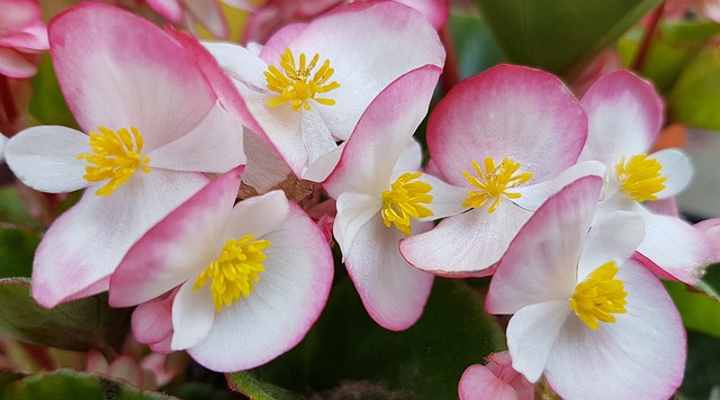
To care properly for wax begonia, give the plant enough indirect sunlight
Wax begonias grow best indoors when they get enough light. Choose an east, west, or south-facing room to encourage healthy growth and plenty of flowers. If there’s not enough light, then begonias perform well in artificial light. The most critical light requirement is to keep wax begonias in indirect sunlight.
The Best Soil for Wax Begonias Houseplants
Wax begonias growing in containers need a light, fertile potting mix that drains well. Use a peat-based potting mix that is amended with perlite to improve drainage. This type of begonia soil allows the roots to stay moist without getting waterlogged. Alternatively, you can buy a commercial potting mix for African violets.
Related reading: Easy DIY potting mix recipes.
How to Water Wax Begonia Plants
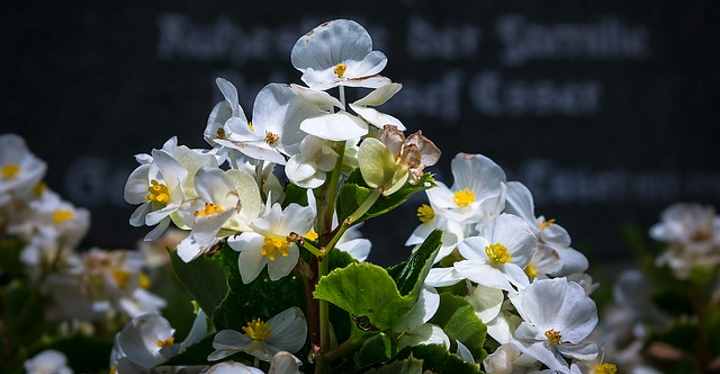
Water wax begonia plant when the top soil is dry and water less in winter
Water wax begonias whenever the top 1” or 2” (2.5 – 5 cm) of soil is dry. During the growing season, you may have to water the tropical potted begonias once or twice a week. To water the plant, pour water through the soil until it drains from the bottom.
The essential growing requirement is to avoid begonia roots sitting in soggy soil. Therefore, it’s crucial to allow the top layer of potting soil to dry before watering. All you need to do is poke your finger into the potting mix to check for moisture.
Here are a few handy tips for watering wax begonia houseplants:
- Allow tap water to sit for 24 hours in an open-topped jar before watering—this allows chemicals to evaporate.
- Always use water at room temperature to avoid shocking the roots.
- Watering less in winter—maybe as little as every four weeks because the begonia houseplants grow slower in winter.
Wax Begonia Temperature and Humidity Requirements
Wax begonias thrive in average room temperatures. The ideal temperature range for begonia semperflorens is between 60°F and 75°F (16°C – 24°C). Growing in these temperatures encourages non-stop blooming.
Try to ensure that wax begonias grow in relative room humidity of around 50 percent. If indoor conditions are especially dry, sit the plant pot on a pebble tray and water. Just make sure that the pot doesn’t sit in water, but on the small stones.
Indoor wax begonias must have good ventilation. If air circulation is inadequate, you may notice signs of fungal issues on foliage—a white powdery substance on leaves caused by mildew.
Fertilizing Wax Begonias Growing in Pots
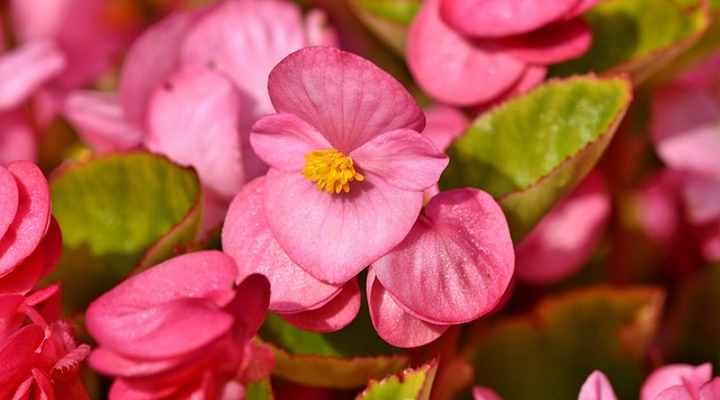
Fertilize lightly wax begonia during spring and summer with a high phosphorus fertilizer
Wax begonia houseplants benefit from regular light fertilizing. Use a diluted houseplant fertilizer that is high in phosphorus. A suitable fertilizer is one with an NPK rating of 10-20-10.
When it comes to fertilizing wax begonia houseplants, here are few things to remember:
- Hold off fertilizing begonias in the fall and winter.
- Every three or four months, flush the potting soil to prevent a buildup of mineral salts.
- Overfertilizing can be just as detrimental to a begonia houseplant as overwatering.
Pruning Wax Begonias
The only time you need to prune a wax begonia is to remove spent flowers. You can also snip off dead stems or leggy growth to improve the plant’s appearance.
If you notice that the wax begonia stems become leggy, it’s a sign that the plant needs more light. Wax begonias don’t grow well or bloom regularly in low light or full shade. So try moving the plant to a brighter location to encourage compact, bushy growth.
Propagating Wax Begonias

The best way to propagate wax begonia is through stem cuttings
Taking stem cuttings is the best way to propagate wax begonias. In spring, cut healthy stems that are 4” (10 cm) long and place them in a small pot containing fresh, moist potting mix to root. Cover the container with a plastic bag to create a humid environment. Keep the soil moist but never soggy.
After a few weeks, the propagated begonia cuttings should have roots, and you can grow your new begonia plant as usual.
Repotting Wax Begonia
Being a low-maintenance houseplant, wax begonias rarely need repotting. Wax begonias grow well when they are somewhat root-bound. The best way to tell if you need to repot the begonia is to see if the plant’s roots hold the potting soil in place.
When repotting a wax begonia, check the fibrous roots for signs of decay or disease. If so, remove the dead or mushy roots before replanting.
Wax begonias are fast growers. So, suppose a begonia has outgrown its pot. In that case, it’s sometimes easier to propagate a plant from new cuttings rather than repotting it.
Pests and Diseases Affecting Wax Begonia Growth Indoors
Common pests affecting potted wax begonia houseplants are thrips and mealybugs. If the soil is too dry, you might get problems with spider mites. If you notice signs of houseplant pests, treat the infestation with neem oil.
Mix 2 tsp. neem oil and 1 tsp. liquid Castile soap with 1 quart (1 l) water. Mix thoroughly in a spray bottle and liberally spray the begonia’s foliage once a week until you get rid of the pests.
Common diseases affecting wax begonias are powdery mildew and root rot. Both conditions are caused by moisture issues—either too much humidity or too much watering.
To treat powdery mildew, use a homemade milk spray to kill the fungal disease. Mix one part of regular milk with two parts of water. Spray the milk solution on the leaves to help get rid of the white powdery substance. Repeat every week until the foliage looks healthy.
To prevent mold issues on leaves, make sure there is enough air circulation and light.
Begonia root rot causes leaves to turn yellow and stems to become black and mushy. If you notice these signs, it’s crucial to repot your plant and remove all parts of decaying roots. If damage is extensive, it may be best to take stem cuttings and propagate a new plant.
Are Wax Begonias Toxic?
Plants in the family Begoniaceae, such as wax begonias, are poisonous to cats and dogs. The ASPCA says that begonias contain soluble calcium oxalates. Ingesting the begonia leaves, stems, or roots can result in vomiting or excessive drooling.
Varieties of Wax Begonia
There are many wax begonias varieties and cultivars that grow as annuals or warm-weather perennials. Here are a few of the most outstanding types of begonias semperflorens:
Ambassador Series Begonias—Wax begonias in the ‘Ambassador’ series have thick oval green leaves and large pink, red, or white flowers. These begonia varieties are resistant to pests and drought.
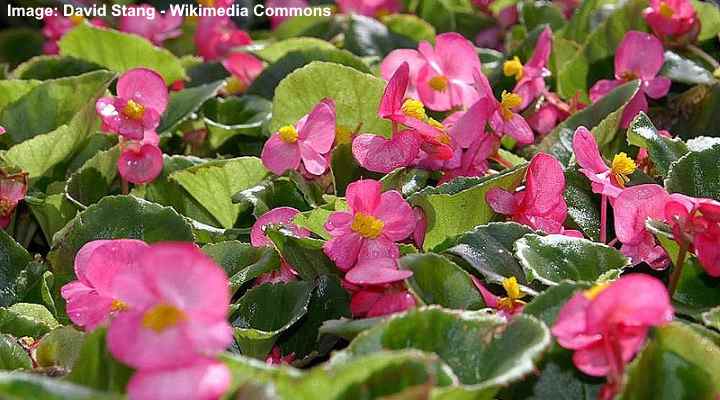
Begonia Ambassador Rose
Begonia Ambassador Scarlet—This wax begonia is a flowering bedding plant with large shiny green leaves and red flowers. The ‘Ambassador Scarlet’ performs well in hanging baskets, flower beds, and containers.
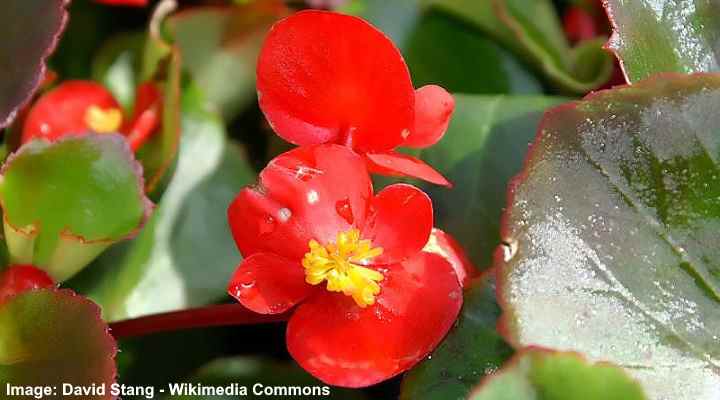
Begonia Ambassador Scarlet
Cocktail Series Begonia—Cocktail begonias are dark-leafed wax begonias that thrive in full sun. The heart-shaped dark leaves and white, pink, or red flowers look stunning in garden beds, borders, or sunny window boxes.
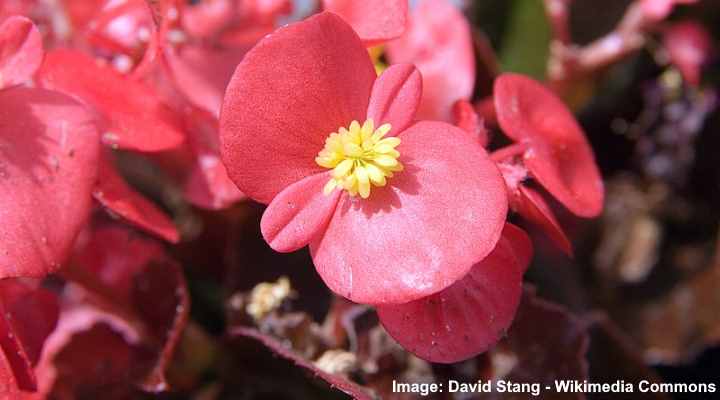
Begonia Cocktail Vodka
Begonia ‘Doublet Red’—The ‘Doublet Red’ is a spectacular red-flowered, dark-leafed wax begonia with showy double flowers. Plant in mass along borders, in containers, hanging baskets, or mixed beds for best effect.
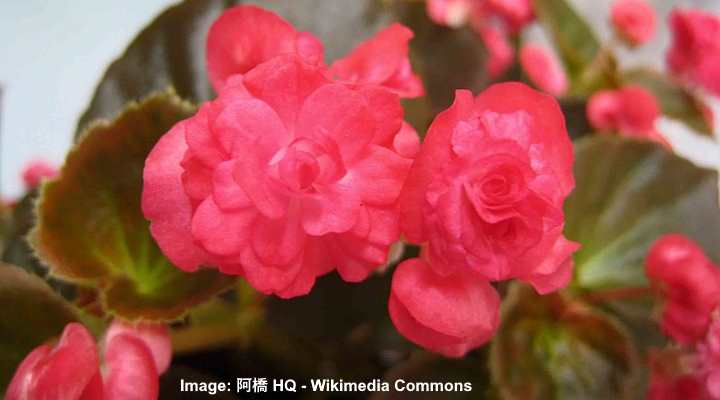
Begonia ‘Doublet Red’
Begonia ‘Party’ Series—The white, red, or pink flowers and dark green or bronze foliage on the ‘Party’ series begonias brighten up any garden. This wax begonia hybrid has large oval leaves, making it able to withstand more sunshine than most begonias.
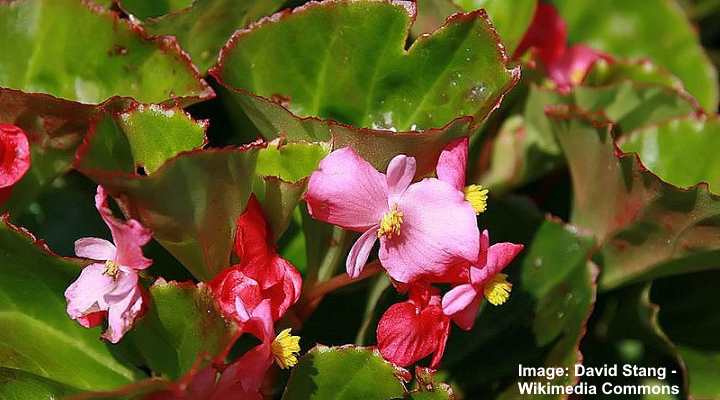
Begonia ‘Party’ Rose Pink
Senator White Begonia—This dark green or bronze-leafed, heat-tolerant begonia semperflorens has spectacular pure white and yellow flowers. It grows 6” to 8” (15 – 20 cm) tall and up to 12” (30 cm) wide.
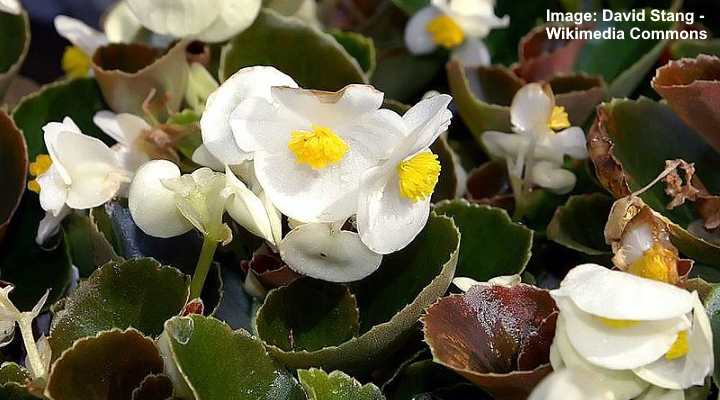
Begonia Senator White
Related articles:
- The Best Flowers for Hanging Baskets
- Beautiful Red Leaf Houseplants
- Begonia Maculata Care: How to Grow Polka Dot Begonia (Wightii)
